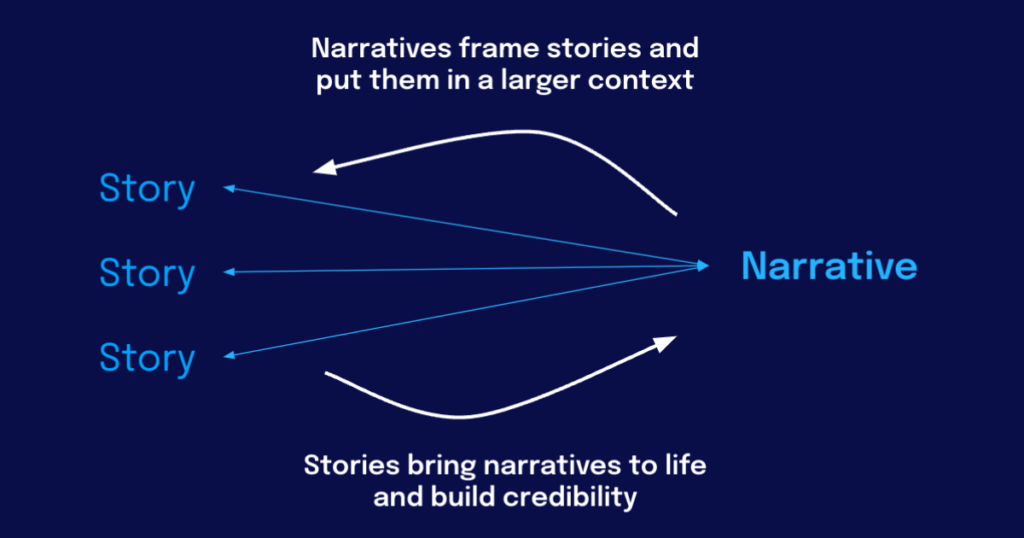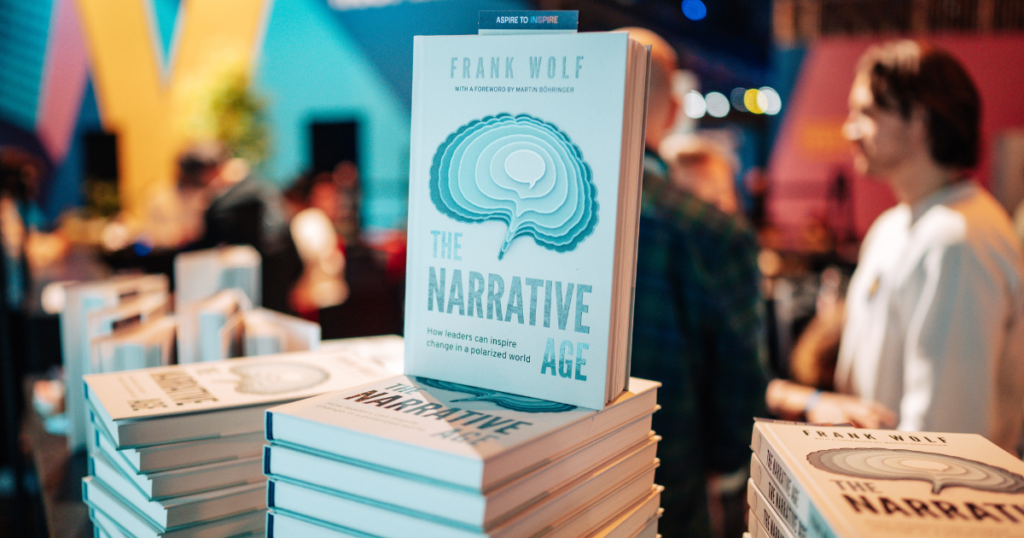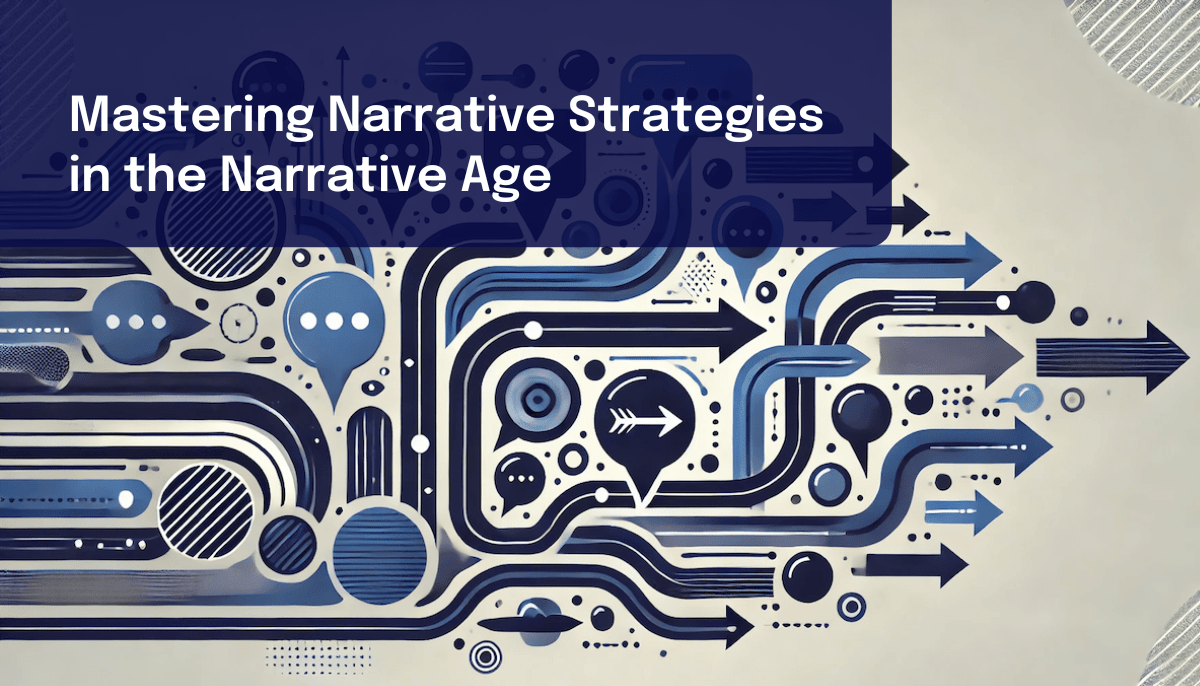Narratives and stories — aren’t they the same thing? When I mention I’ve written a book about narrative, I often hear how important people think storytelling is. I used to think they were interchangeable, too. But after spending over a year researching and writing The Narrative Age, I can tell you with certainty: narrative and story are not the same.
In the business world, this distinction is not just academic — it’s a strategic advantage. Recognizing the difference between narrative and storytelling can unlock transformative power for organizations.
Storytelling vs. narrative: The key differences
A story is a finite account of specific events. It revolves around individual characters and incidents. Together, stories work to bring narratives to life and build credibility. A narrative, on the other hand, is broader and more abstract. It weaves together and frames multiple stories into a cohesive framework, offering deeper meaning and context. Both narratives and stories share a similar structure with a beginning, middle, and end. However, they achieve significantly different objectives.

Let’s look at an example of storytelling. Consider the story of President John F. Kennedy’s 1962 moon speech. It’s a powerful story of ambition — Kennedy’s vision inspired a nation, leading to the collaborative effort of 400,000 engineers and scientists who made the moon landing a reality.
But the narrative behind this story is more expansive. It’s about the human drive to explore, innovate, and achieve the impossible, linking the moon landing to the larger context of the Cold War, the space race, and human ingenuity. As this example illustrates, understanding narratives and mastering their development is a superpower for effective communicators and leaders. To do so, it’s key to comprehend the distinctions that make narratives so unique. That’s why I defined the following 7 narrative virtues for maximum impact:
- Narratives drive action
- Narratives are inclusive
- Narratives are open-ended
- Narratives strengthen with stories
- Narratives frame stories
- Narratives shape opinions
- Narratives measure communication
These seven virtues highlight how narratives, more than individual stories, shape perceptions, guide decisions, and drive long-term change. While stories can entertain and inform, narratives provide the strategic framework that aligns actions, builds trust, and sustains momentum over time.
The 7 narrative virtues in action

To better understand how to reap the full potential of the narrative virtues, I invite you to examine how they all came into play during the enormously successful marketing for the Barbie movie in the summer of 2023.
Narratives drive action
Narratives focus our attention and motivate action. In a world full of distractions, narratives act as filters, guiding us on which topics to prioritize. For instance, the emerging narrative around the Barbie movie in 2023 shifted my attention from dismissing it as a children’s film to considering it a must-watch due to its empowering and subversive storytelling. This shift demonstrates how narratives can channel our motives and direct our willpower toward specific actions, whether it’s choosing a movie, buying a car, or supporting a political campaign.
Narratives are inclusive
Stories are often about others, but narratives invite us to become participants. As I heard more about the Barbie movie, the narrative became less about what others experienced and more about what I might experience. This inclusivity is why narratives are powerful — they turn abstract ideas into personal motivations, allowing people to see themselves in the larger scope and be part of a movement or cause.
Narratives are open-ended
Narratives are systems of stories, some resolved and some not. This open-ended nature allows narratives to evolve. The Barbie movie narrative, for example, evolved from a simple children’s movie to one of the most iconic and successful films of the decade. However, as new stories unfold — such as its impact on future films or controversies surrounding its Oscar nominations — the narrative has continued to grow and adapt.
Narratives strengthen with stories
Narratives grow stronger with each new story or piece of factual information that aligns with them. For instance, every time someone praises the Barbie movie, it reinforces the narrative that it’s a film worth watching. In a business context, consistently aligning stories with a broader narrative can help embed that narrative deeply into the identity and culture of both the company and its audience.
Narratives frame stories
Once a narrative exists, it frames how we perceive new information, creating a confirmation bias. As I encountered both positive and negative opinions about the Barbie movie, my emerging narrative influenced how I processed these views. This framing effect is why established narratives are hard to change and why they are so powerful in guiding how people interpret new information and events.
Narratives shape opinions
When asked about my thoughts on the Barbie movie, my immediate response was shaped by the narrative I had formed: it’s surprising and worth watching. Similarly, when people are asked about their job or a city they’ve visited, they often share a narrative first, followed by a story to illustrate it. This shows how narratives serve as the primary framework through which we share and shape our opinions.
Narratives measure communication
Measuring the effectiveness of communication is challenging, but focusing on narratives provides a way to gauge outcomes. For instance, a simple survey can reveal how much an audience agrees with a given narrative statement. In this way, narratives offer a means to align communication campaigns with desired outcomes, ensuring that the messages conveyed resonate and leave a lasting impact.
For businesses, investing in a well-crafted narrative means creating a cohesive and adaptable framework that supports ongoing success. By understanding and applying these narrative virtues, organizations can harness the full potential of narratives to achieve their goals and create lasting impact.
Why the difference between narrative and storytelling matters to business
Understanding the difference between storytelling and narrative creation is crucial for businesses because narratives shape perception and drive action on a larger scale. Stories might capture a moment, but narratives shape how that moment is remembered and understood. Consider the narrative of your company. What does it convey to the public? What is your reputation sculpted by?
Now let’s shift our focus to the recent collapse of Silicon Valley Bank (SVB). This fiasco illustrates the danger of not having a strong, cohesive narrative. During its financial crisis, SVB’s communication failed to convey a reassuring narrative about financial stability and risk management. The absence of such a narrative left stakeholders scrambling to piece together fragmented stories, resulting in a loss of confidence that triggered a massive bank run.
Just how massive? Panicked SVB clients withdrew $42 billion USD from the bank on in a single day — equivalent to nearly USD 500,000 per second over a 24-hour period. Talk about a company collapsing when they fail to control the narrative!
Narratives provide the context that makes individual stories meaningful and credible. Businesses that successfully build and maintain strong narratives can shape stakeholders’ perceptions positively and enduringly. Ultimately, narratives create a shared understanding of what a company stands for, driving loyalty, guiding decisions, and ultimately influencing success. And sustaining this loyalty — though maintaining your narrative — is the key to lasting business success and customer loyalty.
While stories capture attention and evoke emotions, narratives are what endure and shape our understanding of the world. They are the frameworks that allow us to connect individual acts of storytelling into a cohesive whole, providing a sense of continuity and purpose. And when a strategic narrative is created with purpose and intent, it gives businesses an enormous advantage.
Unlocking the transformative power of narrative

A strong narrative is a strategic asset, acting as a moat that protects a company’s reputation and builds long-lasting trust. Narratives are more than just communication tools — they guide strategic decisions, shape corporate identity, and influence stakeholder behavior.
As a final example to consider today, look at Google’s “Don’t be evil” narrative. For years, this was not just a slogan but a guiding principle that influenced the company’s decisions and actions, from refusing to censor search results in China to contributing to the open-source community. These actions reinforced the narrative, building trust and aligning stakeholders with Google’s values.
However, as circumstances change, so must narratives. Google’s recent challenges with AI competitors like OpenAI’s ChatGPT have put pressure on its narrative of technological leadership. To maintain its competitive edge, Google must evolve its narrative to reflect ongoing innovation while continuing to emphasize its commitment to ethical practices and user trust.
The importance of adaptable narratives is also evident in the other examples we’ve explored. SVB’s lack of a cohesive narrative failed to communicate stability to its customers, leading to a massive loss of confidence. In contrast, Apple has maintained its top market position and reputation for challenging the status quo and driving innovation by consistently aligning its decisions with its established narrative.
A narrative’s power lies in its ability to adapt. To remain relevant, a narrative that once positioned a company as a leader must evolve with new challenges and opportunities. This adaptability is what builds trust and sustains a company’s competitive edge.
Conclusion: Why narrative matters

In today’s fast-paced business environment, where reputations can be quickly damaged, having a strong, adaptable narrative is more important than ever. Narratives provide a coherent framework that helps companies navigate challenges, seize opportunities, and build lasting relationships with stakeholders. It provides organizations with an action plan for success. By investing in and evolving their narratives, businesses can safeguard their reputation and ensure continued success.
While storytelling can win attention, it is narratives that win loyalty and trust over the long term. Understanding and harnessing the power of narrative is not just a communication skill — it’s a strategic imperative. To master the art of crafting powerful business narratives, explore my book, The Narrative Age. It offers practical insights on creating narratives that inspire action and drive success.
In my book, I discuss in detail how to create strategic narratives for your company, as well as many aspects of narrative including measuring narrative impact, organizing ideas through a narrative map, and bringing your narrative to life.



